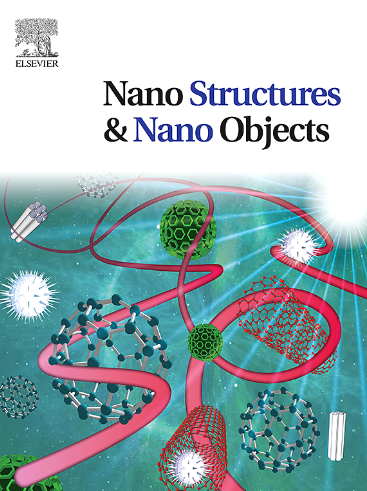绿色生产中氧化铁纳米颗粒对废水中铬(VI)离子的吸附效果
IF 5.45
Q1 Physics and Astronomy
引用次数: 0
摘要
由于Cr(VI)的高毒性,用常规方法去除污染和废水中的Cr(VI)既昂贵又复杂。在这项研究中,利用球孢花提取物制备了氧化铁纳米颗粒(GT-FeONPs),作为一种环保、低成本的去除水介质中铬离子的方法。采用UV-Vis、FT-IR、TEM和XRD等技术研究了合成的GT-FeONPs的特征性质,并进行了去除水溶液中Cr(VI)的实验。在此条件下,确定了最佳初始pH、最佳浓度和最佳温度值。FT-IR光谱分析显示GT-FeONPs被植物成分覆盖,XRD分析显示其晶体平均尺寸为14.34 nm。TEM分析表明,所制备的颗粒为球形纳米结构,平均粒径为10.89 nm。在最佳吸附条件下,pH为2.0时去除率最高。当温度高于40 °C时,去除率下降。采用紫外-可见分光光度计测定不同吸附剂用量对Cr(VI)的最高去除率为88.30 %,可重复使用的最高去除率为91.5 %。将吸附数据应用于Langmuir和Freundlich等温线模型时,发现Langmuir模型更能显示Cr(VI)吸附的平衡形式。确定了最能解释吸附速率机理的动力学模型为伪二级动力学模型。本研究表明,在天花花提取物的活性下合成的FeONPs可以作为吸附剂去除废水中的Cr(VI)离子。本文章由计算机程序翻译,如有差异,请以英文原文为准。
Green production adsorption effect of iron oxide nanoparticles for chromium(VI) ion in wastewater
Due to its high toxicity, the elimination of Cr(VI) in polluted and wastewater by conventional methods is both costly and complex. In this study, iron oxide nanoparticles (GT-FeONPs) were prepared using Globularia trichosantha flower extract as an environmentally friendly, low-cost method to remove chromium ions from aqueous media. The characteristic properties of the synthesized GT-FeONPs were researched by UV-Vis, FT-IR, TEM and XRD techniques, followed by sequential experiments to remove Cr(VI) from aqueous solutions. In this context, the optimum initial pH, optimum concentration and optimum temperature values were determined. FT-IR spectrum analysis revealed that GT-FeONPs were covered by plant components and XRD analysis revealed that the crystals had an average size of 14.34 nm. TEM analysis revealed that the particles were spherical and nanostructured with an average size of 10.89 nm. When optimum adsorption conditions were provided, the highest removal efficiency was realized at pH 2.0. At temperatures higher than 40 °C, the removal rate decreased. Absorption measurements using UV–vis spectrophotometer with different amounts of adsorbent showed that the highest removal rate of Cr(VI) was 88.30 % and the highest removal rate for reuse was 91.5 %. When the adsorption data were applied to both Langmuir and Freundlich isotherm models, it was found that the Langmuir model was more powerful in showing the equilibrium form of Cr(VI) adsorption. The kinetic model that best explained the adsorption rate mechanism was determined to be the Pseudo Second Order Kinetic model. This study shows that FeONPs synthesized under the activity of Globularia trichosantha flower extract can be utilized as adsorbents to remove Cr(VI) ions from wastewater.
求助全文
通过发布文献求助,成功后即可免费获取论文全文。
去求助
来源期刊

Nano-Structures & Nano-Objects
Physics and Astronomy-Condensed Matter Physics
CiteScore
9.20
自引率
0.00%
发文量
60
审稿时长
22 days
期刊介绍:
Nano-Structures & Nano-Objects is a new journal devoted to all aspects of the synthesis and the properties of this new flourishing domain. The journal is devoted to novel architectures at the nano-level with an emphasis on new synthesis and characterization methods. The journal is focused on the objects rather than on their applications. However, the research for new applications of original nano-structures & nano-objects in various fields such as nano-electronics, energy conversion, catalysis, drug delivery and nano-medicine is also welcome. The scope of Nano-Structures & Nano-Objects involves: -Metal and alloy nanoparticles with complex nanostructures such as shape control, core-shell and dumbells -Oxide nanoparticles and nanostructures, with complex oxide/metal, oxide/surface and oxide /organic interfaces -Inorganic semi-conducting nanoparticles (quantum dots) with an emphasis on new phases, structures, shapes and complexity -Nanostructures involving molecular inorganic species such as nanoparticles of coordination compounds, molecular magnets, spin transition nanoparticles etc. or organic nano-objects, in particular for molecular electronics -Nanostructured materials such as nano-MOFs and nano-zeolites -Hetero-junctions between molecules and nano-objects, between different nano-objects & nanostructures or between nano-objects & nanostructures and surfaces -Methods of characterization specific of the nano size or adapted for the nano size such as X-ray and neutron scattering, light scattering, NMR, Raman, Plasmonics, near field microscopies, various TEM and SEM techniques, magnetic studies, etc .
 求助内容:
求助内容: 应助结果提醒方式:
应助结果提醒方式:


